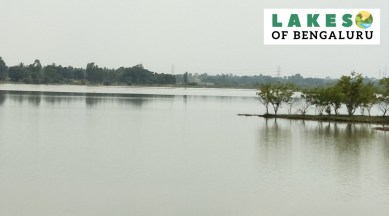Stay updated with the latest - Click here to follow us on Instagram
Lakes of Bengaluru: Restoration of this waterbody stopped farmers from quitting agricultural activities
With the drying up of the lake, the bed was not only encroached by private persons but was also used to throw garbage

The Mahadeva-Kodigehalli Lake is situated in the village that goes by the same name in North Bangalore taluk spreads over an extent of 130 acre and is surrounded by agriculture fields. The main water source for the lake is rainwater and outflow of upstream lakes.
According to a research conducted by the Indian Institute of Science (IISc), Bengaluru, in 2017, the water sample of the Mahadeva-Kodigehalli Lake revealed that the waterbody is suitable for fisheries and domestic human activities. The turbidity was very high because of runoff and erosion from the nearby agriculture fields due to rain
monthly limit of free stories.
with an Express account.
The water analysis was done on the request of an NGO, Eco-Watch, that later restored the lake in 2019.
Local residents around the lake say that the Mahadeva Kodigehalli Lake till two decades ago provided water to the people of Vidyaranyapura, Kodigehalli and Bommasandra villages. The lake in the early 2000’s had dried completely.
With the drying up of the lake, the bed was not only encroached by private persons but was also used to throw garbage.
“With the support of CSR funds, the lake was restored in 2019. Today the lake holds 6,20,750 gallons of water and the water table in the area has also increased. The restoration of the lake really helped the farmers nearby. The restoration of the lakes improves the water quality of the area,” said Srinath K, a nearby resident.
He added, “Due to the dumping of waste materials in the lake, the inlet channels of the water body were completely blocked.”
Another resident, Srinivasa M, said, “When the lake dried up, the groundwater table went down and farmers began quitting agricultural activities. After the restoration, the lake was handed over to a committee which comprises local villagers who take care of the lake.”
As a part of the restoration, desilting and dredging of the lake was done by the NGO. Rain water percolation pits at the inlet channel were also constructed. The lake is dependent on rainwater.
According to IISc researcher Dr T V Ramachandra, “During 1800, there were 1452 water bodies in Bengaluru with the storage capacity of 35 TMC. The number of lakes in Bangalore has reduced from nearly 285 in the early seventies to 194 now.”
The IISc had recommended to Eco-Watch that there should be no introduction of exotic species of fauna (fish, etc.) and boats with motors should be avoided to prevent water contamination through spillages of fuel.